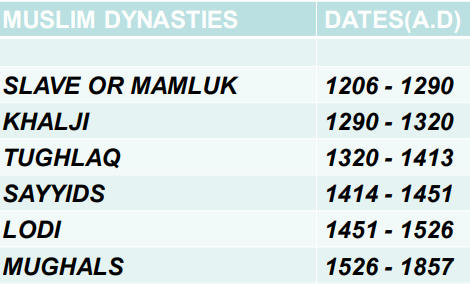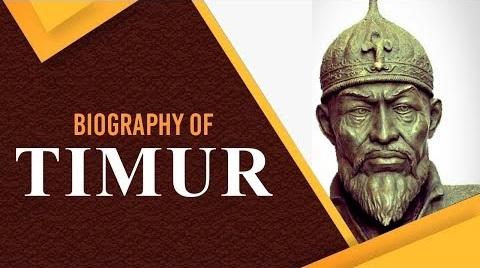Table of Contents
MUSLIM DYNASTIES

TIMUR
- Born into the Barlas confederation in Transoxiana (in modern-day Uzbekistan) on 9 April 1336, Timur gained control of the western Chagatai Khanate by 1370.
- He led military campaigns across Western, South and Central Asia the Caucasus and southern Russia, and emerged as the most powerful ruler in the Muslim world after defeating the Mamluks of Egypt and Syria, the emerging Ottoman Empire, and the declining Delhi Sultanate.
- From these conquests, he founded the Timurid Empire, but this empire fragmented shortly after his death.
RISE
- Timur was the last of the great nomadic conquerors of the Eurasian Steppe, and his empire set the stage for the rise of the more structured and lasting Gunpowder Empires in the 16th and 17th centuries.
- He was a member of the Barlas, a Mongolian tribe. About 1360, Timur gained prominence as a military leader whose troops were mostly Turkic tribesmen of the region.
- Timur began to gain a following of people in Balkh, consisting of merchants, fellow tribesmen, Muslim clergy, aristocracy and agricultural workers, because of his kindness in sharing his belongings with them
EXPANSION
- Timur spent the next 35 years in various wars and expeditions. He not only consolidated his rule at home by the subjugation of his foes, but sought extension of territory by encroachments upon the lands of foreign potentates.
- In 1383, Timur started his lengthy military conquest of Persia, though he already ruled over much of Persian Khorasan by 1381.Timur then began a fiveyear campaign to the west in 1392, attacking Persian Kurdistan.
INVASION ON INDIA
- In 1398, Timur invaded northern India, attacking the Delhi Sultanate ruled by Sultan Nasir-ud-Din Mahmud Shah Tughluq of the Tughlaq dynasty.
- The battle took place on 17 December 1398. Sultan Nasir-ud-Din Mahmud Shah Tughluq and the army of Mallu Iqbal had war elephants armored with chain mail and poison on their tusks.
- Nasir-ud-Din Mahmud Shah Tughluq fled with remnants of his forces. Delhi was sacked and left in ruins. Before the battle for Delhi, Timur executed 100,000 captives
BRUTAL
- The capture of the Delhi Sultanate was one of Timur’s greatest victories, arguably surpassing the likes of Alexander the Great and Genghis Khan because of the harsh conditions of the journey and the achievement of taking down one of the richest cities at the time.
- Before the end of 1399, Timur started a war with Bayezid I, sultan of the Ottoman Empire, and the Mamluk sultan of Egypt.
- In 1400, Timur invaded Christian Armenia and Georgia. Of the surviving population, more than 60,000 of the local people were captured as slaves
DEATH
- Then Timur turned his attention to Syria, sacking Aleppo and Damascus. Timur invaded Baghdad in June 1401. After the capture of the city, 20,000 of its citizens were massacred.
- Timur invaded Anatolia and defeated Bayezid in the Battle of Ankara on 20 July 1402.
- In December 1404, Timur began military campaigns against Ming China and detained a Ming envoy. He suffered illness while encamped on the farther side of the Syr Daria and died at Farab on February 17, 1405, before ever reaching the Chinese border
EFFECTS OF INVASION
- Timur was also very ambitious and huge wealth of Hindustan had attracted his attention.
- In his autobiography, Timur has stated, “My object in the invasion of Hindustan is to lead an expedition against the infidels, to convert them to the true faith of Islam and purify the land itself from the filth, infidelity and polytheism.”Timur wanted to make the best use of the political chaos of India.
- About the fate of Delhi, he further wrote, “Unhappy city was turned into a place of bloodshed, ruin and destruction.” Regarding looting and plundering he observed, “There were immense spoils of rubies, diamonds, pearls, gold and silver ornaments and vessels.”






















 WhatsApp
WhatsApp